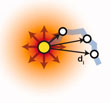Research Area A
Publications 2013
17-Jan-2014
Volume changes associated with protein folding reactions contain valuable information about the folding mechanism and the nature of the transition state. However, meaningful interpretation of such data requires that overall volume changes be deconvoluted into individual contributions from different structural components. Here we focus on one type of structural ... READ MORE
26-Nov-2013
Nanosized mesoporous silica particles with high colloidal stability attract growing attention as drug delivery systems for targeted cancer treatment and as bioimaging devices. This Perspective describes recent breakthroughs in mesoporous silica nanoparticle design to demonstrate their high potential as multifunctional drug delivery nanocarriers. These types of ... READ MORE
29-Oct-2013
Aim: This study examines the absolute quantification of particle uptake into cells. Methods: We developed a novel method to analyze stacks of confocal fluorescence images of single cells interacting with nano-and micro-particles. Particle_in_Cell-3D is a freely available ImageJ macro. During the image analysis routine, single cells are reconstructed in 3D and split ... READ MORE
25-Oct-2013
Copper-catalysed alkyne–azide 1,3-dipolar cycloaddition (CuAAC) is the predominantly used bioconjugation method in the field of activity-based protein profiling (ABPP). Several limitations, however, including conversion efficiency, protein denaturation and buffer compatibility, restrict the scope of established procedures. We introduce an ABPP customised click ... READ MORE
08-Oct-2013
The dynamics of peptide α-helices have been studied extensively for many years, and the kinetic mechanism of the helix–coil dynamics has been discussed controversially. Recent experimental results have suggested that equilibrium helix–coil dynamics are governed by movement of the helix/coil boundary along the peptide chain, which leads to slower unfolding ... READ MORE
27-Aug-2013
Three new cytosine derived DNA modifications, 5-hydroxymethyl-2′-deoxycytidine (hmdC), 5-formyl-2′-deoxycytidine (fdC) and 5-carboxy-2′-deoxycytidine (cadC) were recently discovered in mammalian DNA, particularly in stem cell DNA. Their function is currently not clear, but it is assumed that in stem cells they might be intermediates of an active demethylation ... READ MORE
01-Jul-2013
In this paper we investigate the photochromic ring-opening reaction of 2,2-diphenyl-5,6-benzo(2H)chromene. In particular, we study the uncertainties and contradictions in various published reaction models using a combination of transient absorption and fluorescence spectroscopy with femtosecond time resolution. We propose a simplified reaction scheme which is in good ... READ MORE
20-Jun-2013

We report an efficient synthesis of the hypermodified natural tRNA modifications wybutosine (yW) and hydroxywybutosine (OHyW). We also describe the preparation of isotopically labeled analogues for precise quantification of yW and OHyW in different tissues including plant materials. The synthesis involved the formation of the unusual tricyclic ring structure of ... READ MORE
20-Jun-2013

The total syntheses of the natural product 3-O-methylfunicone (1), a member of the funicone class of compounds, and its derivatives is reported. The key reactions in the construction of the biaryl ketone core are a regioselective TMPZnCl•LiCl halogenation and a carbonylative Stille cross-coupling reaction. In addition, the inhibitory activities of the funicones ... READ MORE
20-Jun-2013
8-Oxopurines (8-oxodG and 8-oxodA) and formamidopyrimidines (FaPydG and FaPydA) are major oxidative DNA lesions involved in cancer development and aging. Their mutagenicity is believed to result from a conformational shift of the N9-C1′ glycosidic bonds from anti to syn, which allows the lesions to form noncanonical Hoogsteen-type base pairs with incoming ... READ MORE
19-Jun-2013
Tet proteins oxidize 5-methylcytosine (mC) to generate 5-hydroxymethyl (hmC), 5-formyl (fC), and 5-carboxylcytosine (caC). The exact function of these oxidative cytosine bases remains elusive. We applied quantitative mass-spectrometry-based proteomics to identify readers for mC and hmC in mouse embryonic stem cells (mESC), neuronal progenitor cells (NPC), and adult ... READ MORE
19-Jun-2013
Recently three new nucleobases were discovered in DNA isolated from mouse embryonic stem cells. The three nucleobases are oxidation products of 5-methylcytosine (mC), which is a base that regulates transcriptional activity. The oxidation reaction of 5-methylcytosine to 5-hydroxymethylcytosine (hmC), 5-formylcytosine (fC), and finally 5-carboxycytosine (caC) is now ... READ MORE
12-Jun-2013

The intramolecular and intermolecular vibrational energy flow in a polyproline peptide with a total number of nine amino acids in the solvent dimethyl sulfoxide is investigated using time-resolved infrared (IR) spectroscopy. Azobenzene covalently bound to a proline sequence containing nitrophenylalanine as a local sensor for vibrational excess energy serves as a ... READ MORE
16-May-2013
Duocarmycin-derived seco-cyclopropabenzindole (CBI) drugs have been shown to bind DNA and an aldehyde dehydrogenase (ALDH1A1) in lung cancer cells. The removal of the DNA-binding indole moiety results in a CBI compound that does not bind to DNA in whole cells but still exhibits remarkable cytotoxicity. This CBI compound ... READ MORE
30-Jan-2013
Catch me if you can: The ClpP protease mediates protein homeostasis and can be efficiently inhibited by β-lactones. A combination of molecular docking, mutagenesis, activity-based protein profiling, and kinetics studies now reveals the mechanism of ClpP inhibition. A hydrophobic pocket next to the active site allows ... READ MORE


